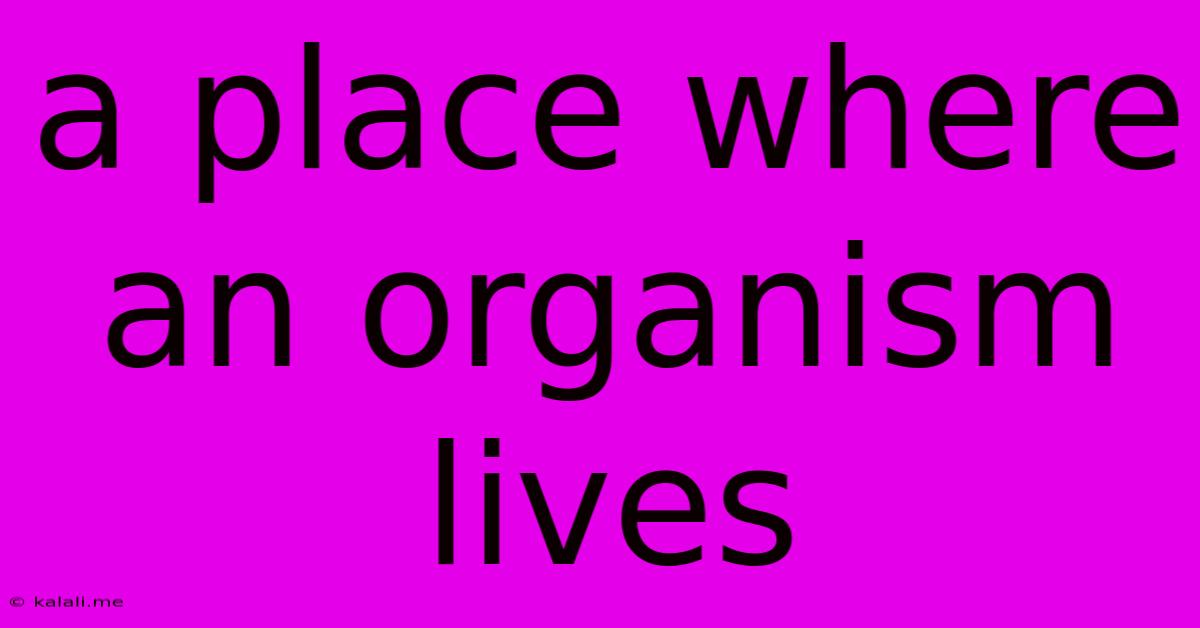A Place Where An Organism Lives
Kalali
Jun 14, 2025 · 3 min read

Table of Contents
Habitat: A Place to Call Home for Every Organism
The term "habitat" is more than just a place where an organism lives; it's a complex interplay of physical and biological factors that determine its survival and success. Understanding habitats is crucial for conservation efforts and appreciating the intricate web of life on Earth. This article will delve into the definition of habitat, its key components, the different types of habitats, and the threats they face.
What is a Habitat?
A habitat, simply put, is the natural environment where an organism lives. This environment provides everything the organism needs to survive, including food, water, shelter, and space to reproduce. It encompasses both biotic (living) and abiotic (non-living) factors. Think of it as the organism's "address" within the larger ecosystem. A successful habitat allows for a species to thrive and maintain a healthy population. Understanding a species' habitat requirements is fundamental to predicting its distribution and vulnerability.
Key Components of a Habitat
Several crucial elements contribute to a functional habitat:
-
Food: The availability of appropriate food sources is paramount. This can range from specific plants for herbivores to prey animals for carnivores. The abundance and distribution of food directly influence population size.
-
Water: Access to clean water is essential for hydration, thermoregulation, and many other bodily functions. The quality and quantity of water available significantly impact an organism's survival.
-
Shelter: This provides protection from predators, harsh weather conditions, and other environmental stressors. Shelter can take many forms, from burrows and nests to dense vegetation or rocky crevices.
-
Space: Organisms require sufficient space for foraging, mating, raising young, and avoiding competition with others. Overcrowding can lead to resource depletion and increased competition.
-
Temperature: The ambient temperature profoundly affects an organism's metabolism and survival. Many species are adapted to specific temperature ranges and cannot tolerate extreme fluctuations.
-
Light: Light availability is critical for photosynthesis in plants and plays a role in the behavior and physiology of many animals. The amount and intensity of light influence the distribution of organisms within a habitat.
Types of Habitats
The diversity of habitats on Earth is astonishing, ranging from vast oceans to towering mountain ranges. Some common habitat types include:
-
Terrestrial Habitats: These are land-based habitats, such as forests, grasslands, deserts, and tundra. Each is characterized by distinct climate conditions and vegetation.
-
Aquatic Habitats: These are water-based habitats, including oceans, lakes, rivers, and wetlands. They can be further categorized into freshwater and marine environments.
-
Marine Habitats: These include coral reefs, kelp forests, and open ocean zones, each with its unique biodiversity.
-
Freshwater Habitats: These range from fast-flowing rivers to still ponds and lakes, each supporting distinct communities of organisms.
Threats to Habitats
Many habitats are facing significant threats from human activities, including:
-
Habitat loss and fragmentation: Deforestation, urbanization, and agricultural expansion are destroying and fragmenting habitats, leaving organisms with less space and resources.
-
Climate change: Shifting temperatures, altered precipitation patterns, and increased frequency of extreme weather events are impacting the suitability of many habitats.
-
Pollution: Air, water, and soil pollution contaminate habitats and harm organisms.
-
Invasive species: Introduced species can outcompete native organisms and disrupt ecosystem balance.
Conclusion
The concept of a habitat is fundamental to understanding the ecology of organisms. Protecting and restoring habitats is crucial for maintaining biodiversity and ensuring the survival of countless species. By acknowledging the interconnectedness of organisms and their environments, we can work towards creating a more sustainable future for all.
Latest Posts
Latest Posts
-
Which Of The Following Is A Unit Vector
Jun 15, 2025
-
Find An Equation Of The Circle Whose Diameter Has Endpoints
Jun 15, 2025
-
The Part Of The Earth Where Life Exists
Jun 15, 2025
-
University Of California Santa Barbara Sat Scores
Jun 15, 2025
-
Which Of The Following Is Not A Communication Style
Jun 15, 2025
Related Post
Thank you for visiting our website which covers about A Place Where An Organism Lives . We hope the information provided has been useful to you. Feel free to contact us if you have any questions or need further assistance. See you next time and don't miss to bookmark.